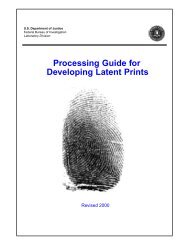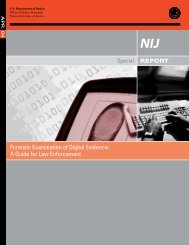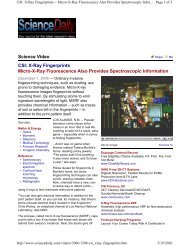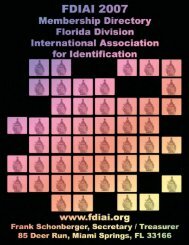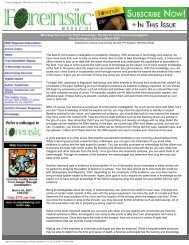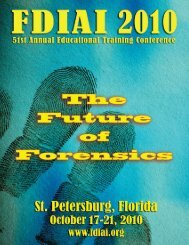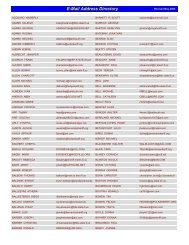scientific working group on imaging technologies (swgit) - the FDIAI
scientific working group on imaging technologies (swgit) - the FDIAI
scientific working group on imaging technologies (swgit) - the FDIAI
You also want an ePaper? Increase the reach of your titles
YUMPU automatically turns print PDFs into web optimized ePapers that Google loves.
For Crime Scene Technicians and Law Enforcement Officers-Level 1<br />
(With video or adjustable still cameras)<br />
1. Basic levels of skill and knowledge for recording a crime scene<br />
a. Various images to take<br />
b. Set-ups for each type of image<br />
2. A <str<strong>on</strong>g>working</str<strong>on</strong>g> knowledge of <strong>the</strong> fundamentals of photography and/or videography<br />
3. The proper collecti<strong>on</strong> and preservati<strong>on</strong> of <strong>the</strong> recording media<br />
4. Create and maintain <strong>the</strong> chain of custody.<br />
5. A <str<strong>on</strong>g>working</str<strong>on</strong>g> knowledge of <strong>the</strong> capabilities and limitati<strong>on</strong>s of equipment<br />
6. Select and operate <strong>the</strong> appropriate cameras (digital, video, or film) and<br />
accessories.<br />
7. Dem<strong>on</strong>strate competence.<br />
8. Dem<strong>on</strong>strate proficiency through testing.<br />
For <strong>the</strong> Crime Scene Technicians-Level 2<br />
(Capable of training Level 1 and Law Enforcement Officers)<br />
1. Comprehensive knowledge of and experience in forensic photography techniques,<br />
such as:<br />
a. Impressi<strong>on</strong> evidence such as fingerprints, and/or blood spatter.<br />
b. Selecti<strong>on</strong> of <strong>the</strong> appropriate film and equipment based <strong>on</strong> knowledge of <strong>the</strong><br />
capabilities and limitati<strong>on</strong>s of <strong>the</strong> various aspects of <strong>imaging</strong>. Solve difficult<br />
n<strong>on</strong>-routine <strong>imaging</strong> problems.<br />
2. Awareness of film processing and image processing opti<strong>on</strong>s, for example, <strong>the</strong><br />
effects of <strong>the</strong> push process or c<strong>on</strong>trast adjustments.<br />
3. Videography techniques. (refer to LEVA Guidelines at www.leva.org)<br />
4. Know how to use <strong>the</strong> most comm<strong>on</strong> image processing tools and techniques.<br />
5. Dem<strong>on</strong>strate competence.<br />
6. Dem<strong>on</strong>strate proficiency through testing.<br />
For <strong>the</strong> Imaging Specialist- Pers<strong>on</strong>nel include photographic specialists, forensic scientists<br />
and forensic video analysts. These pers<strong>on</strong>nel are capable of training Law Enforcement<br />
Officers and Level 1 and Level 2 Crime Scene Technicians.<br />
1. Working knowledge of how to use <strong>the</strong> various applicable aspects of <strong>the</strong> <strong>imaging</strong><br />
chain.<br />
2. Expertise in using techniques applicable to a particular discipline, for example:<br />
a. Photogrammetry<br />
b. Surveillance <strong>imaging</strong><br />
c. Frequency domain c<strong>on</strong>versi<strong>on</strong>, for example, Fast Fourier Transform<br />
filtering.<br />
d. Alternate light sources and c<strong>on</strong>trast filtering.<br />
4. Dem<strong>on</strong>strate competence.<br />
5. Dem<strong>on</strong>strate proficiency through testing.



